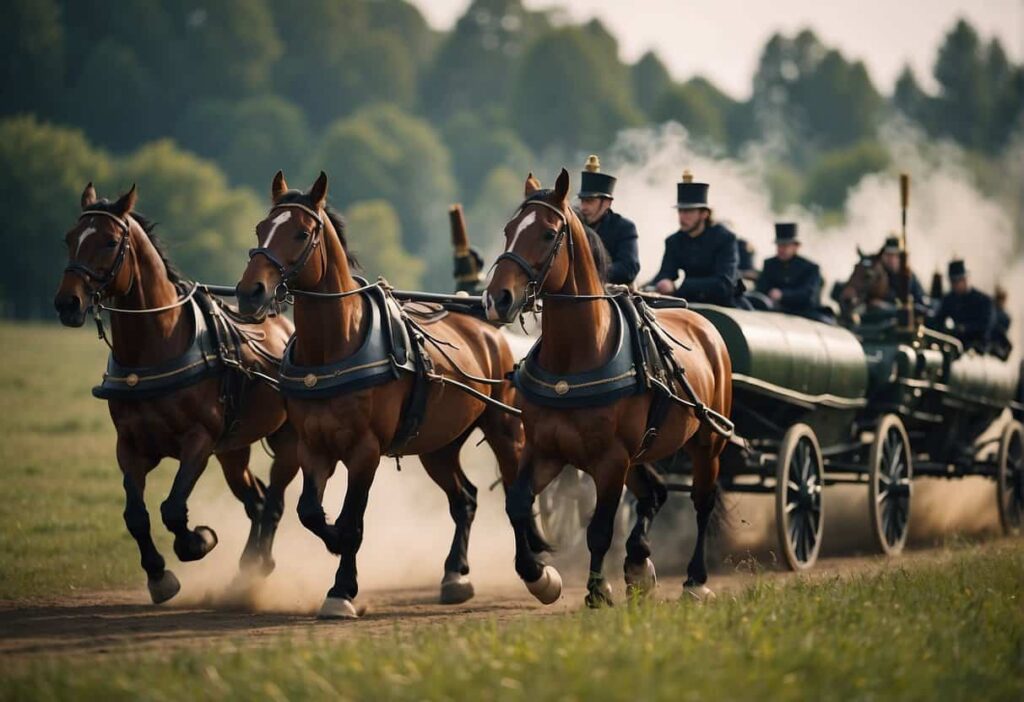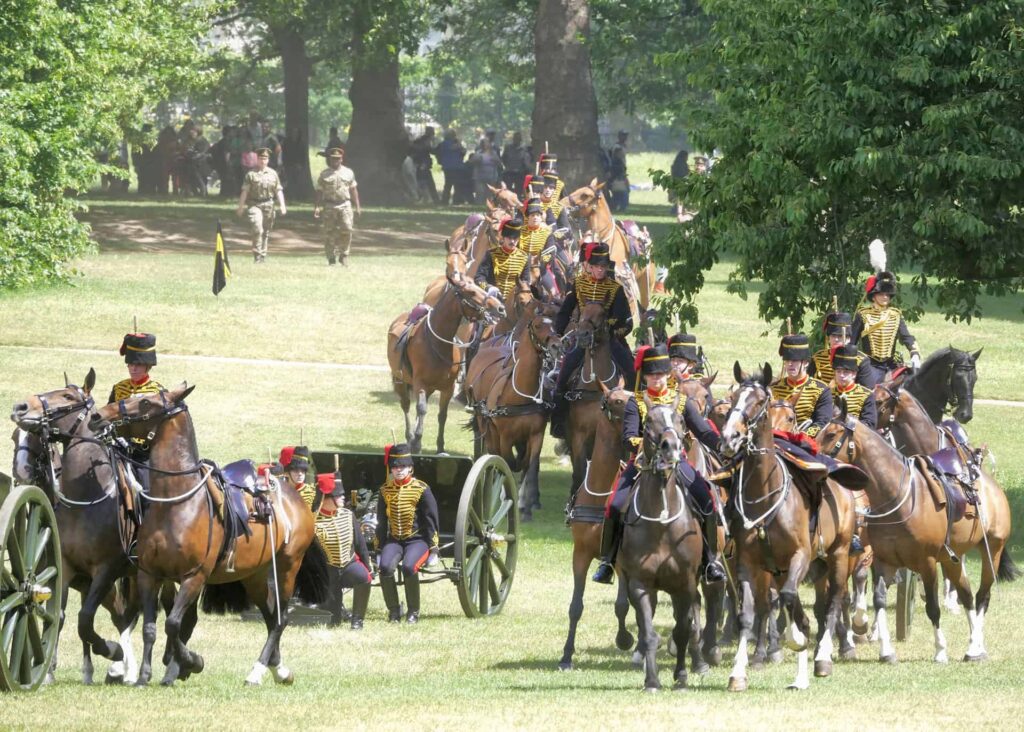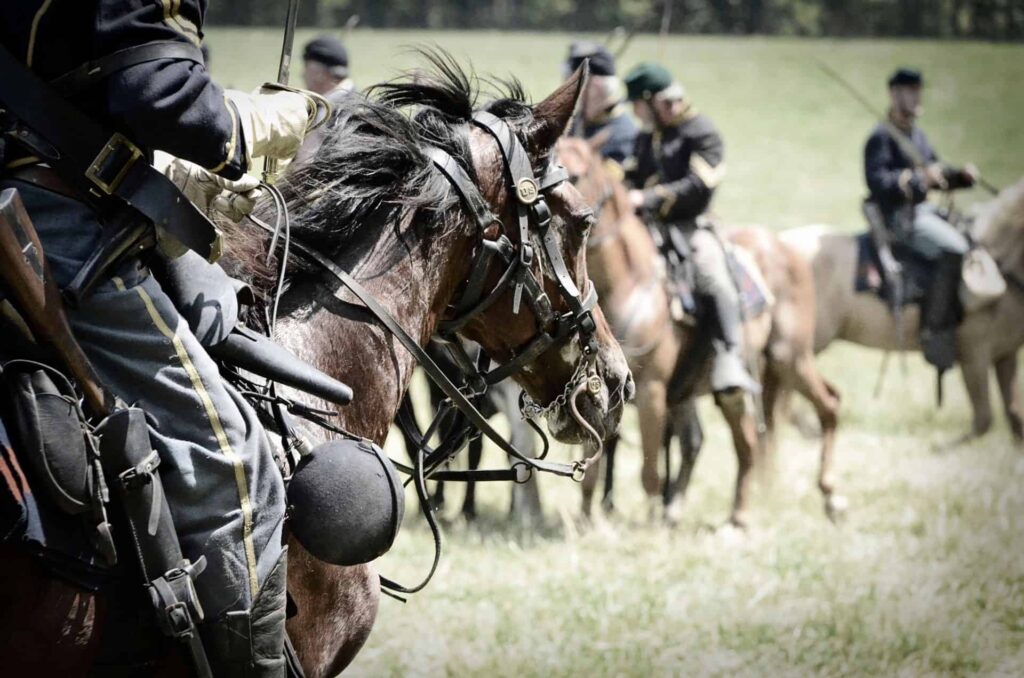Horse artillery, also known as mounted artillery, represents a highly mobile branch of the army that combines the mobility of cavalry with the firepower of artillery. They have been engineered for speed and maneuverability. Historically, these units played a pivotal role on the battlefield owing to their ability to move quickly, set up, fire, and relocate with an agility unmatched by foot artillery. By harnessing the speed of horses, they could support fast-moving cavalry operations or respond swiftly to shifts in battle dynamics.
This component of an army was distinct in its formation and tactics, with its crew typically trained to ride horses alongside the guns, unlike traditional artillery where movement was slower and more cumbersome. Horse artillery was a game-changer in warfare; it increased the pace of combat and allowed for more dynamic use of artillery on the battlefield. With specialized equipment and training, these units could engage the enemy, provide critical support, and alter the course of engagements effectively.
Key Takeaways
- Horse artillery units were essential for their rapid deployment capabilities in battle.
- They played a crucial role in supporting fast-paced cavalry operations.
- The flexibility and speed of horse artillery significantly impacted historical warfare tactics.
Historical Development of Horse Artillery
Horse artillery units have been a dynamic component of military forces through the ages. They combined the mobility of cavalry with the devastating power of artillery, which has evolved to meet the demands of warfare and ceremony.
Origin and Early Use
Horse artillery made its mark during the Thirty Years’ War, when Gustavus Adolphus incorporated mobile artillery pieces into his army, drastically altering the traditional methods of warfare. This innovation enhanced battlefield strategies with the swift repositioning of cannons, enabling a more flexible and responsive artillery force.
Advancements During Major Conflicts
In the French Revolutionary Wars and the Napoleonic Wars, the horse artillery was utilized extensively by the French Revolutionary Army. Their ability to rapidly reposition helped to break the static nature of warfare at the time. The units were integral in delivering quick and effective firepower that could support the fast-moving columns of infantry and cavalry.
Evolution in the 20th Century
World War I and World War II saw significant changes in military technology. However, horse artillery was still present during the early stages of World War I (also known as the First World War), although its role diminished as the conflict progressed and modern mechanized warfare emerged. By the Second World War, horse-drawn artillery was largely outmoded due to the advent of motorized vehicles.
Modern Relevance and Ceremonial Use
The King’s Troop, Royal Artillery, is now one of the few remaining units that preserve the tradition of horse artillery. Stationed at King George VI Lines, they perform ceremonial duties such as Trooping the Colour. They serve as a link to military heritage, showcasing the historical importance and prestige of horse artillery in modern times.

Organizational Structure of Horse Artillery
The organizational structure of horse artillery is integral to its function on the battlefield, bolstering both mobility and firepower. It allows for rapid deployment and the ability to support cavalry operations effectively.
Regiments and Units
The British Army’s Royal Horse Artillery, established as a distinct component of the Royal Regiment of Artillery, consisted of several regiments and batteries, such as the famed 1st Regiment and 3rd Regiment. Often, these were further divided into smaller units, designated as Battery M or Battery C, depending on their specific role within the brigade.
Command and Control
Command and Control within horse artillery was crucial to maintain discipline and ensure efficient operation during engagements. Within the British Army, the King’s Troop and Household Division exerted command over the Royal Horse Artillery, aligning with the larger framework of the Household Cavalry. The U.S. Army adopted a similar structure for their own U.S. Horse Artillery Brigade, incorporating lessons from European counterparts.
Training and Discipline
Rigorous training and adherence to strict discipline were indispensable for units like the King’s Life Guard and the Royal Horse Artillery. Prestigious institutions such as West Point instilled these values in aspiring officers, ensuring they were well-prepared for the demands of leading riding troops and managing the hybrid of cavalry and artillery.
Integration with Cavalry
The integration with cavalry took various forms, from traditionally structured cavalry units to more irregular horse artillery units. This fusion was epitomized by entities like the Flying Artillery, a term used to describe horse artillery’s rapid movements on the field. Mounted infantry and dragoons often worked in concert with horse artillery to maximize their combat effectiveness.

Operational Tactics and Equipment
In the realm of horse artillery, operational tactics are intricately connected to the mobility provided by horses and the kind of equipment used, such as lightweight guns and caissons. The efficiency and rapid deployment of artillery units during combat pivot on these elements.
Mobility and Deployment
Horse artillery units were heralded for their remarkable mobility and swift deployment on the battlefield. Light artillery pieces, often the Ordnance QF 13-pounder, were well-suited for rapid maneuvers and repositioning, enabling a shoot-and-scoot approach. This tactic allowed artillery units to fire and then quickly move to avoid counter-battery fire.
- Self-propelled artillery: Not applicable, as horse artillery relies on animal mobility.
- Deployment Speed: Essential for maintaining the element of surprise and tactical advantage.
Artillery Pieces and Ammunition
The guns and ammunition of horse artillery were designed for ease of transport and quick action. 13-pounder guns and light howitzers comprised the core of the forces, with the Ordnance QF 13-pounder being a common sight. Ammunition included innovations like Henry Shrapnel’s explosive shells, which significantly increased battlefield effectiveness.
- Guns Used: Predominantly light cannons for rapid movement.
- Ammunition Type: Emphasis on shrapnel shells for maximized area impact.
Support Elements
The support elements consisted of vital components like supply wagons, caissons, and limbers. These vehicles carried additional ammunition and essentials for the artillery, ensuring sustained operations and enabling units to engage in continuous mobile fire support.
- Caissons: Carried ammunition and were vital for logistical support.
- Limbers: Attached to horses, these facilitated the guns’ transport and quick deployment.
Significant Engagements and Battles
Throughout history, horse artillery has been a pivotal element in many major conflicts. They have provided swift-moving firepower that has proved decisive in various engagements, supporting cavalry charges and strengthening infantry formations.
Landmark Battles Involving Horse Artillery
Antietam (1862): Marked as one of the bloodiest single-day battles in American history, horse artillery played a critical role during the Battle of Antietam. Their quick mobility allowed Union forces to deploy rapid and effective artillery support at critical points on the battlefield.
Brandy Station (1863): Often remembered as the largest cavalry engagement of the American Civil War, it drew significant contributions from horse artillery. The intense bombardments by horse-drawn batteries shaped the course of this battle, underscoring their importance in cavalry-dominated engagements.
Waterloo (1815): Napoleon Bonaparte’s defeat at Waterloo was a turning point in European history, where horse artillery was extensively employed. They provided crucial fire support during key moments of this battle, directly influencing its outcome.
The Role of Horse Artillery in Warfare Strategy
Battle Integration: As fast-moving units, horse artillery was adept at integrating with cavalry and infantry formations. By swiftly repositioning, they could create a dynamic rearguard or augment frontal assaults with barrages that broke enemy lines.
Tactical Versatility: Their ability to tie together different segments of an army showcased the versatility of horse artillery. They were often the linchpin in warfare strategies, capable of transforming the momentum of battles with timely and precise firepower.

Cultural and Historical Impact
Horse artillery has deeply influenced military traditions and heritage, leaving tangible marks of remembrance through various memorials and museums.
Tradition and Heritage
Tradition plays a pivotal role in military units, particularly those with long-standing historical significance such as the Royal Regiment of Artillery. Positioned at the Royal Artillery Barracks in London, this regiment has upheld centuries of heritage intertwined with horse artillery. They are custodians of a martial lineage that harks back to moments when swift-moving artillery — mounted on horseback — was crucial in shaping battlefield tactics. Events at locations like Goodwood, West Sussex, known for its equestrian history, help perpetuate these military customs and remember the roles horses played in the service.
Memorials and Museums
Memorials dedicated to horse artillery and its personnel can often be found in historical military sites. One example is the Royal Artillery Barracks, which stands both as a living institution and as a memorial to generations of soldiers and horses who served within its ranks. Moreover, institutions like the National Army Museum in London capture and present the essence of these martial traditions to the public, offering a detailed account of the horse artillery’s influence on military developments and British Army lore. At these venues, items such as uniforms, weaponry, and personal artifacts from the era of horse artillery are meticulously preserved and displayed, bringing the profound cultural and historical impact of horse artillery into contemporary perspective.
Geographical Distribution and Variants
The variants of horse artillery and their distribution reflect different military doctrines and geographic requirements. In Europe, the origins and evolution are closely tied to socioeconomic factors and the need for mobility in warfare, whereas outside Europe, the adoption and adaptation of horse artillery have been influenced by different terrains and combat situations.
European Context of Horse Artillery
In Europe, horse artillery was revolutionary for its speed and the support it provided to cavalry units. The Netherlands was one such place where this concept took hold in the early stages but it saw a significant evolution with time. Frederick the Great of Prussia observed the effectiveness of horse artillery and incorporated it into his forces. His Prussian troops benefited from such mobile firepower during his numerous military campaigns. Austria and Hanover also developed their own forms, honing the art of the quick movement of guns.
Woolwich in England became a hub for the innovative design and training of horse artillery units. As a result, the British units became a model for others, showing a high degree of professionalism and effectiveness in various European conflicts.
Horse Artillery Beyond Europe
Outside of Europe, horse artillery adapted to varying terrains and circumstances. The Russian Army, operating over vast tracts of land with extreme weather conditions, modified its use of horse artillery to suit its expansive battlefields. They developed lighter, more maneuverable equipment to respond to the broad-ranging requirements of their geography.
In the Americas, different contexts led to unique adaptations. The Confederate Army during the American Civil War utilized horse artillery to compensate for their lack of manpower, attempting to increase their battlefield mobility and strike capability. In South America, as nations became independent, they looked to European models to structure their own military units, leading to the development of horse artillery adapted to the diverse ecosystems from the pampas to the Andes.
Victor von Trew and other military strategists from various regions recognized the impact that well-deployed horse artillery could have on the outcomes of battles and overall campaigns, shaping the utilization and tactical integration of these units worldwide.
Frequently Asked Questions
This section provides insightful answers to common inquiries regarding the unique aspects and historical evolution of horse artillery, with a focus on the Royal Horse Artillery.
What distinguished the horse artillery from other artillery units during the Napoleonic Wars?
The horse artillery was notable for its mobility, facilitated by horses that transported both the guns and the gunners. This allowed them to support cavalry actions with speed and flexibility, often being the deciding factor in battlefield engagements.
How did the role of the Royal Horse Artillery evolve during World War I?
During World War I, the Royal Horse Artillery adapted to modern warfare by integrating indirect fire methods and using motorized transport to improve mobility, reflecting the shift from cavalry charges to more static trench warfare.
What are the characteristic features of the uniform worn by the Royal Horse Artillery?
Royal Horse Artillery uniforms historically featured dark blue tunics with distinctive braiding and a busby, which is a tall fur cap, as part of their full dress. These elements represented their elite status and distinguished them from other artillery units.
Can you describe the ranking structure within the Royal Horse Artillery?
The ranking structure of the Royal Horse Artillery is similar to other British Army units, with ranks ranging from Gunner up to Major General, indicating positions of increasing authority and responsibility within the regiment.
What is the significance of the cap badge in the Royal Horse Artillery?
The cap badge of the Royal Horse Artillery is a significant emblem that represents its identity and heritage, featuring a cannon, reminiscent of their historical role as a mobile artillery unit, and often includes the Royal Cypher as a mark of royal patronage.
How did the British artillery units, including the Royal Horse Artillery, adapt to technological changes in warfare?
British artillery units, like the Royal Horse Artillery, evolved by incorporating new technologies such as improved artillery guns, radios for better communication, and mechanization to enhance their strategic role on the modern battlefield.
Last Updated on December 30, 2023 by Nate Dewsbury



